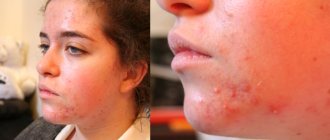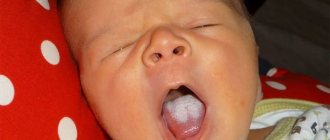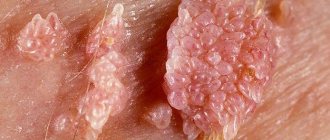Urogenital candidiasis, or yeast fungus in women, is a serious disease that requires mandatory treatment. It promotes the development of infections in the genital organs, causes vaginal stenosis, and can cause miscarriages during pregnancy and inability to conceive.
This fungal infection is transmitted sexually, so a carrier of the fungus must use condoms during sexual intercourse. Personal hygiene of women occupies an important place.
Causes
In girls, a yeast infection can be observed after childbirth if the mother was a carrier of yeast-like fungi. Infection occurs during childbirth, when the child moves through the woman's birth canal. In childhood, infection can also occur:
- if a woman does not wash her mammary glands before breastfeeding;
- if a child is given a dirty pacifier;
- with the introduction of low-quality complementary foods.
Fungal diseases in women are caused by the following factors:
- hormonal imbalance in the body;
- disturbances in the functioning of the immune system;
- AIDS and HIV;
- regular use of underwear made of synthetic fabrics;
- disturbances in the functioning of the endocrine system;
- regular use of hormonal drugs, antibiotics and contraceptives;
- intrauterine devices, caps and diaphragms;
- frequent douching;
- lack of personal hygiene.
All these reasons provoke the appearance of infection or increase the activity of yeast-like fungi.
How does candidiasis manifest?
Fungal infections manifest themselves in different ways. It all depends on the gender of the patient, the general condition of the body and the presence of concomitant pathologies. Due to the rapid course of the disease in women, men are confident that thrush will bypass them.
To dispel these prejudices, it is enough to consider the characteristics of the manifestation of yeast fungus in representatives of both sexes.
Candidiasis in women
Every woman can get candidiasis, regardless of her sexual activity and cleanliness. Most often, yeast infections affect the genitals, and if left untreated, thrush spreads to the skin.
It is especially dangerous during pregnancy, as it can cause premature birth or miscarriage. During childbirth, yeast spores enter the baby's mouth and then infect the skin, genitals and internal organs.
Related article:
Treatment of nail fungus with Climbazole. Reviews, instructions and prices.
Candidiasis in men
Men experience all the insidiousness of yeast fungus, since their thrush is asymptomatic. They can infect their sexual partners for years without even knowing it. All the beauty of yeast manifests itself when immunity decreases or in the presence of provoking factors.
Candidiasis can appear not only on the genitals, but also on the skin. Most often, thrush affects the skin folds, perineum, armpits and lower abdomen.
Symptoms of thrush:
| What women face | What worries men |
| White curdled discharge with an unpleasant odor | Itching, swelling and redness of the glans penis |
| Itching, swelling and soreness of the genitals | Discharge in the foreskin area |
| White coating on the tongue and near the gums with damage to the oral cavity | Difficulty retracting and extending the head |
| Painful urination | Painful urination |
If you experience any discomfort in the genital area, you should definitely visit a specialist. Only he knows how to guarantee a cure for candidiasis, and not drive it into a state of dormancy. When self-medicating, you have to deal with chronic thrush, which greatly reduces the quality of life.
Yeast fungus in men and women: causes, symptoms and factors - video
Symptoms and diagnosis
Despite the various causes of yeast infection , the following symptoms are observed during infection:
- severe burning and itching in the perineal area;
- there are difficulties when urinating;
- a cheesy substance is released from the vagina;
- the labia are swollen;
- yeast-like fungi cause a sour, pungent odor;
- During menstruation and during sexual intercourse, itching and pain intensify.
At an advanced stage of fungal diseases, remissions and relapses are possible. This indicates that the disease has become chronic . In such cases, women may complain of the following health and well-being disorders:
- for increased fatigue;
- aggressiveness and irritability;
- uncontrolled appetite;
- depression;
- constant unmotivated anxiety;
- joint pain;
- itching in the anal area.
If you delay treatment of the disease, yeast-like fungi can be observed not only in the vagina. A fungal infection affects the nails, mammary glands, interdigital areas of the hands and feet.
Before treating the disease, diagnostic measures are carried out to identify spores and the yeast-like fungi themselves. Laboratory tests are used for this:
- PCR or molecular biological methods that can detect DNA in some types of yeast;
- macroscopic analysis, which helps to detect fungal elements, single budding cells, the presence of spores and infections, thanks to which you can accurately establish a diagnosis;
- DIF or direct immunofluorescence methods;
- cultural method, which is applied to a woman with a chronic form of the disease in the relapse stage;
- a microscopy method during which a smear is taken from the vagina.
Diet
H2_3
In addition to using antifungal drugs, it is very important to pay due attention to nutrition. During treatment, limit the consumption of foods that provoke the growth of yeast fungi and replace them with foods that will help the body fight the infection. Detailed information about the diet is in the article on our website -
This will help strengthen your child's immune system faster and get rid of yeast.
A healthy baby means a happy mother. We all remember this advertising slogan well. Indeed, there is nothing more worrying for a mother than a sick child. A young, not yet strong, organism is exposed to the environment much more intensely than an adult organism. Therefore, the main responsibility of parents is to vigilantly monitor the health of their baby.
A child’s skin is a delicate, thin covering that is designed to protect the body from infections, but due to its thinness, increased vascularity and, in addition, the immaturity of the immune system, it is not always able to withstand the aggressive effects of the environment. Therefore, fungal infections in children are not uncommon. And it is very important to identify the disease as soon as possible in order to begin treatment immediately.
Creams and ointments
If yeast-like fungi are found in a woman’s body, it is advisable to use topical preparations. These include creams and ointments. Recommended drugs in this group:
- “Dalacin”;
- “Klofan.”
- “Clotrimazole.”
These products should not be used on deeply affected areas.
It relieves unpleasant symptoms, is well absorbed into the mucous membrane, and helps destroy yeast.
Thrush in pregnant women
In pregnant women, the discharge resembles whey. Over time, they take on a thicker consistency and have an unpleasant odor. If treatment for the disease is not started promptly, the following symptoms may appear:
- painful and pulling sensations in the lower abdomen;
- cutting pain when urinating;
- bloody or bloody discharge.
Often the disease is accompanied by bacterial vaginosis , which leads to serious consequences for the health of the expectant mother.
When this disease is diagnosed, immediate treatment is necessary.
In late pregnancy, urogenital candidiasis can cause serious complications . The mucous membranes lose their elasticity, so ruptures may occur during childbirth. If a woman has previously had a caesarean section, the surgical suture may become thinner, which can cause uterine rupture along the scar. This will lead to large blood loss, and there is a risk of not saving the fetus.
Due to the disease, the tone of the uterus increases, which can cause oxygen deficiency in the fetus . Often these children are diagnosed with various developmental pathologies. Inside the womb, there is a high probability of developing sepsis. This is a dangerous disease that leads to serious consequences and can threaten the lives of the expectant mother and baby.
The most common negative manifestation of the disease is infection of the baby during passage through the birth canal.
Classification of mycoses
Mycoses in children according to the type of pathogen are divided into:
- Keratomycosis
- Dermatophytosis
- Candidiasis
The former are characterized by skin damage, but without inflammatory processes. The latter are caused by mold fungi and are accompanied by inflammatory processes on the skin of varying degrees, damage to nails and hair. Candidiasis is caused by exposure to yeast and fungal infections that affect the skin and mucous membranes.
So, every mother should carefully monitor the condition of the skin on the baby’s body (arms, neck, stomach, back, butt, head, face) during daily hygiene procedures. When drying your baby after bathing, you need to constantly pay attention to the scalp, face, legs, arms, butt, and the condition of the nails and hair.
Folk remedies
When treating urogenital candidiasis, you can use traditional medicine. The instructions provide recommendations on how to treat the disease using medicinal herbs.
Decoctions are effective remedies. To prepare them you need to take 1 tbsp. l. raw materials, pour a glass of boiling water over it and let it brew for 20 minutes. The resulting mixture is drunk three times a day until the negative symptoms completely disappear.
The following herbs are recommended:
- chamomile;
- sequence;
- St. John's wort;
- sage;
- celandine;
- nettle;
- yarrow;
- knotweed
A decoction of burdock and elecampane roots can be used for douching. To do this, mix the raw materials in equal proportions, pour 200 g of boiling water over it and simmer the mixture a little in a water bath. The broth is settled and filtered. It must be used slightly warm. Moisten a tampon in the prepared mixture and wipe the genitals with it. A tampon can be inserted into the vagina for 10-15 minutes.
You can also prepare a solution of cocoa and fir oil. This is an effective remedy in the treatment of candidiasis. To do this, the components are mixed in a ratio of 1:10. The mixture is boiled and cooled. A tampon is moistened in it and inserted into the vagina before bed. In the morning, they take it out and wash the genitals with running water.
The procedure is carried out until the discharge completely disappears.
A similar procedure can be carried out with honey. For this you need 1 tsp. Dissolve honey in a glass of boiling water. Cool the mixture slightly. In the composition, wet a tampon and insert it into the vagina overnight. Before the procedure, it is recommended to test for an allergic reaction.
To do this, apply the finished product to the bend of the elbow and observe the changes in the skin for 20 minutes. If there is no redness or irritation of the epidermis, the product can be used for treatment.
A decoction of calendula will help in the fight against candidiasis. The flowers of the plant are poured with 200 g of boiling water and the decoction is infused for 15 minutes. A cotton swab is moistened in it and inserted into the vagina.
Should be kept for at least 30 minutes. After the time has elapsed, remove the tampon and wash the genitals with running water. It is good to carry out the procedure before bed.
Prevention
To avoid the risk of yeast infection, the following preventive measures are recommended. They will help prevent the onset of the disease or minimize negative consequences. A woman should:
- maintain personal hygiene regularly;
- during menstruation, take a shower at least 2 times a day;
- It is recommended to wash yourself after each bowel movement;
- change pads every 3 hours;
- change the tampon every 4 hours;
- do not use non-sterile materials during menstrual periods;
- avoid underwear made from synthetic fabrics;
- have a permanent sexual partner;
- do not use other people’s personal hygiene items;
- for preventive purposes, take a course of probiotics to restore normal microflora in the intestines and avoid the development of dysbiosis.
Danger of disease
Untimely treatment of urogenital candidiasis can lead to serious complications:
- the infection may spread to the skin and nails;
- possible damage to the genitourinary system;
- there is a risk of developing infertility;
- During pregnancy and childbirth, infection of the fetus may occur;
- the disease can take a chronic form with constant relapses.
To avoid complications , it is important to consult a doctor at the first signs of the disease. The disease has a favorable treatment prognosis if candidiasis does not become chronic and adequate drug therapy is selected.
Local treatment of fungal infections
Erosion on the child’s body is treated daily with antiseptic solutions. This may be boric acid, furatsilin or potassium permanganate. Particular attention is paid to the areas between the fingers. Different types of lichen are treated with ointments, these include tar, zinc, salicylic acid, naphthalene, the drugs Miconazole and Clotrimazole.
Attention! The antifungal agent that the doctor prescribed after identifying the causative agent of the fungal infection must be taken in accordance with the instructions. In particular, it must be used for a specified period of time. This is the only way to ensure that the infection completely disappears.
If an antifungal is stopped prematurely, there is a risk that the remaining pathogen still in the affected area of the body will multiply again and cause a relapse of the disease.
Topical antifungals are intended for topical external use only. Antifungal agents, available in the form of ointments, creams or lotions, are applied to the affected areas of the body as prescribed by the doctor.
This superficial therapy is common for fungal infections of the skin as well as the mucous membranes. The most commonly used topical antifungals for topical use include:
- Narrow spectrum antifungals are Tolnaftate and Nystatin, which have been shown to be very effective against yeast fungi.
- Broad-spectrum antifungals, which include azoles such as Clotrimazole, Bifonazole. These also include Econazole, Miconazole and Ketoconazole. In addition, doctors prescribe Amorolfine and Terbinafine as broad-spectrum fungicidal antimycotics.
If your doctor has prescribed a topical antifungal, you usually don't have to worry about serious side effects. For topical medications, side effects are limited to skin reactions, such as skin irritation.
Unlike topical treatment, antifungal drugs are taken orally. Systemic antifungals must be taken by the patient either orally in tablet form or intravenously.
If long-term treatment with local antifungal agents has not shown any effect, the child is prescribed systemic antifungal drugs.











